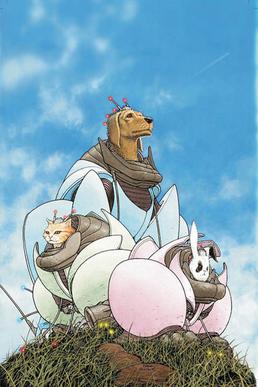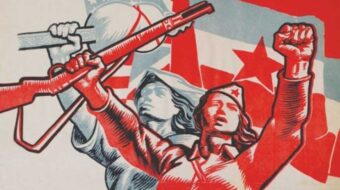
This year marks the 10th anniversary of the publication of We3, a masterful comic book miniseries that considers human exploitation of animals, specifically in war and scientific testing. Written with a haunting minimalism by Grant Morrison and illustrated in a beautiful, yet unflinching style by Frank Quitely, the title deserves to be more widely read.
Following three companion animals on the run, We3 could be viewed as a dystopic reimagining of Sheila Burnford’s novel, The Incredible Journey, which was most recently adapted into the 1993 film, Homeward Bound.
The story centers on a dog, cat and rabbit who have been kidnapped from their human families by the American military and transformed into monstrous, animal-machine hybrids capable of unleashing lethal destruction at the order of a Uncle Sam. When the secret project is decommissioned and the animals ordered to be killed, their sympathetic human handler sets them free. The trio make adesperate escape into the nearby wilderness as the military uses every means at its disposal to track and destroy them.
While we later learn the animals’ original names were Bandit, Tinker, and Pirate, the military refers to them simply by numbers. This small aspect of the plot demonstrates one way in which humans attempt to erase animal individuality or personhood to justify their exploitation. Similarly, when the trio’s handler appears distraught after being commanded to exterminate the animals, a colleague counsels her, saying, “You know it’s best not to get attached to things.” Again, it’s clear that in order rationalize their abuse of the trio, these human characters, as we do in real life, must think of animals
as closer to objects than sentient beings.
Because Bandit, Tinker and Pirate are constructed through testing and intended to be employed in armed conflict, the use of animals in experimentation and warfare is central to the plot. As one scientist states, the trio “are surgically engineered, bio-modified organisms.” And the wiring attached to their heads is undoubtedly meant to visually evoke the electrodes implanted in animals during real-life testing. The trio’s intended military function is even more explicit, with a scientist, for instance, proclaiming, “Our wars of tomorrow will be fought by remote controlled animals, like these.” Given that the story is told primarily from the animals’ perspective, with the trio as protagonists and the military as antagonists, it’s portrayal of the use of animals in warfare and experimentation is inherently negative. Morrison’s editorializing occasionally even slips into the language of the military and scientists, with one official, for instance, referring to engineered animals like Bandit, Tinker, and Pirate as “slaves.”
The most obvious weakness of We3 as progressive art is in the form of animal exploitation and non-human victims it chooses to focus on. For instance, correctly or not, humans generally don’t feel a significant stake in the issue of animal testing, as whatever benefits it might accrue are out of sight. Further, cats and dogs especially are species that humans are already socialized to sympathize with to a certain degree. The title would be much more challenging to our mores
were it to center on animal agriculture, a wider-spread form of abuse to which we are more intimately connected on a daily basis through our food. Or it would be better if, staying with the testing focus, its central characters were rats, or another species humans traditionally view as having little value as individuals.
Despite its limitations, We3 helps sensitize us to our exploitive relationship toward other animals. Its illustrations are exquisitely drawn, though at times horrifically violent. It’s a quick read and on its 10th anniversary I really recommend you give it a try. You don’t have to be a comic connoisseur to love it.
Photo: Wikipedia (CC)












Comments